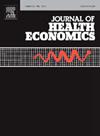Seasonal allergies and mental health: Do small health shocks affect suicidality?
IF 3.6
2区 经济学
Q1 ECONOMICS
引用次数: 0
Abstract
Suicide rates increased 37% in the US from 2000 to 2018; while structural factors are extensively studied, short-term triggers remain less understood. We examine the impact of small exogenous shocks – allergies triggered by seasonal pollen – on suicides. Pollen allergies diminish cognitive function and disrupt sleep—predictors of suicidality. Combining disparate datasets across 34 localities in the United States from 2006 to 2018, we use a specification with granular fixed effects to identify the effect of pollen on suicides from daily variation in each. We find that as pollen levels rise, the count of suicides in a county increases – up to 7.4% more suicides when pollen levels at their highest levels. We find that individuals with a known mental health condition or treatment have 8.6% higher incidence of suicides on days with highest pollen. We also show that this effect is not spurious – Google searches for allergy and depression symptoms increase substantively as pollen levels rise. These estimates are robust to multiple specifications. As climate change extends and intensifies the pollen season, we expect its impact to more than double the number of suicides by the end of the century. These results point toward the importance of relatively small exogenous shocks on suicidality and the potential for relatively inexpensive and routine health care measures such as allergy testing and treatment to improve mental health.
季节性过敏和心理健康:小的健康冲击会影响自杀吗?
2000年至2018年,美国的自杀率上升了37%;虽然结构性因素得到了广泛的研究,但短期触发因素仍鲜为人知。我们研究了由季节性花粉引发的小外源冲击对自杀的影响。花粉过敏会降低认知功能,破坏睡眠预测自杀。结合2006年至2018年美国34个地区的不同数据集,我们使用具有颗粒固定效应的规范,从每个地区的日常变化中确定花粉对自杀的影响。我们发现,随着花粉水平的上升,一个县的自杀人数也会增加——当花粉水平达到最高水平时,自杀人数会增加7.4%。我们发现,在花粉最高的日子里,有已知精神健康状况或治疗的个体的自杀率高出8.6%。我们还表明,这种影响不是虚假的——谷歌对过敏和抑郁症状的搜索随着花粉水平的上升而大幅增加。这些估计对于多个规范是可靠的。随着气候变化延长和加剧花粉季节,我们预计到本世纪末,其影响将使自杀人数增加一倍以上。这些结果指出了相对较小的外源性冲击对自杀的重要性,以及相对便宜和常规的医疗保健措施的潜力,如过敏测试和治疗,以改善心理健康。
本文章由计算机程序翻译,如有差异,请以英文原文为准。
求助全文
约1分钟内获得全文
求助全文
来源期刊

Journal of Health Economics
医学-卫生保健
CiteScore
6.10
自引率
2.90%
发文量
96
审稿时长
49 days
期刊介绍:
This journal seeks articles related to the economics of health and medical care. Its scope will include the following topics:
Production and supply of health services;
Demand and utilization of health services;
Financing of health services;
Determinants of health, including investments in health and risky health behaviors;
Economic consequences of ill-health;
Behavioral models of demanders, suppliers and other health care agencies;
Evaluation of policy interventions that yield economic insights;
Efficiency and distributional aspects of health policy;
and such other topics as the Editors may deem appropriate.
 求助内容:
求助内容: 应助结果提醒方式:
应助结果提醒方式:


